An Introduction to a California Visionary

Granville Seymour Redmond stands as a pivotal figure in American art history, particularly celebrated for his evocative depictions of the California landscape. Active during the late 19th and early 20th centuries, Redmond masterfully navigated the stylistic currents of his time, becoming one of the foremost painters associated with California Impressionism and Tonalism. His life and work are rendered even more remarkable by the fact that he achieved artistic prominence after losing his hearing at a very young age. Redmond's canvases capture the unique light, vibrant colors, and diverse terrains of California, leaving behind a legacy that continues to resonate with art lovers and historians alike.
Born in Philadelphia, Pennsylvania, on March 9, 1871, Granville Redmond's life took a dramatic turn around the age of two or three. An illness, most commonly identified as scarlet fever, left him profoundly and permanently deaf. This early life challenge, however, did not stifle his innate artistic inclinations. Instead, it arguably heightened his visual perception and sensitivity, faculties that would become central to his artistic expression. His inability to hear shaped his way of experiencing the world, focusing his attention on the visual nuances of light, form, and movement.
In 1874, seeking better opportunities or perhaps a more conducive environment, Redmond's family relocated across the continent to San Jose, California. This move proved fortuitous, placing the young Redmond in the state that would become the primary subject and inspiration for his life's work. California's burgeoning cultural scene and stunning natural beauty provided the backdrop against which his artistic talents would blossom.
Early Education and Artistic Awakening
Redmond's formal education began at the California School for the Deaf in Berkeley (then located in San Francisco, later moved to Berkeley). This institution played a crucial role in his development, not only providing him with communication skills but also nurturing his artistic talents. From 1879 to 1890, he studied under the guidance of Theophilus Hope d'Estrella, a talented artist who was also deaf. D'Estrella recognized Redmond's potential and provided instruction in painting, drawing, and sculpture.
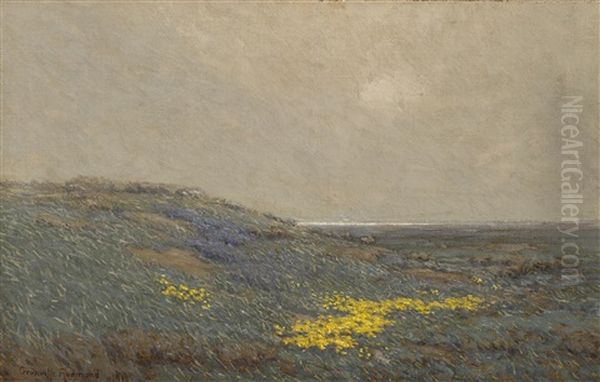
Beyond traditional art forms, Redmond also excelled in pantomime under d'Estrella's tutelage. This skill in non-verbal expression would later prove significant, connecting him with the world of silent film and influencing his interactions with figures like Charlie Chaplin. His teacher, d'Estrella, was a significant early influence, instilling in Redmond a foundation in artistic techniques and encouraging his passion for visual representation.
Following his foundational studies at the School for the Deaf, Redmond's talent earned him admission to the California School of Design in San Francisco. There, he studied from 1890 to 1893 under respected instructors such as Arthur Mathews and Amedee Joullin. Mathews, a highly influential figure in the California Arts and Crafts movement and Tonalism, likely imparted a sense of atmospheric mood and decorative composition. Redmond excelled, demonstrating exceptional promise and dedication. His hard work culminated in receiving the prestigious W.E. Brown Medal of Excellence from the school, a testament to his burgeoning abilities.
Recognizing his exceptional talent, the California School for the Deaf awarded Redmond a scholarship to further his studies abroad. This opportunity allowed him to travel to Paris, the epicenter of the art world at the time, and immerse himself in European artistic traditions and contemporary movements.
Parisian Studies and European Influences
Arriving in Paris in 1893, Redmond enrolled at the prestigious Académie Julian, a private art school favored by many international students, including numerous Americans. There, he studied under the guidance of prominent academic painters Jean-Paul Laurens and Jean-Joseph Benjamin-Constant. These instructors emphasized rigorous academic training, focusing on draftsmanship, composition, and anatomical accuracy. While Redmond absorbed these academic principles, he was also inevitably exposed to the revolutionary currents of Impressionism and Post-Impressionism that permeated the Parisian art scene.
During his time in Paris, Redmond shared a studio with fellow sculptor Douglas Tilden, another graduate of the California School for the Deaf who was achieving international recognition. He also formed friendships with other artists, including the California painter Gottardo Piazzoni. Piazzoni, known for his Tonalist landscapes, likely shared Redmond's affinity for capturing atmospheric effects and poetic moods in nature. The exchange of ideas and experiences with fellow artists, both American and European, undoubtedly enriched Redmond's artistic perspective.
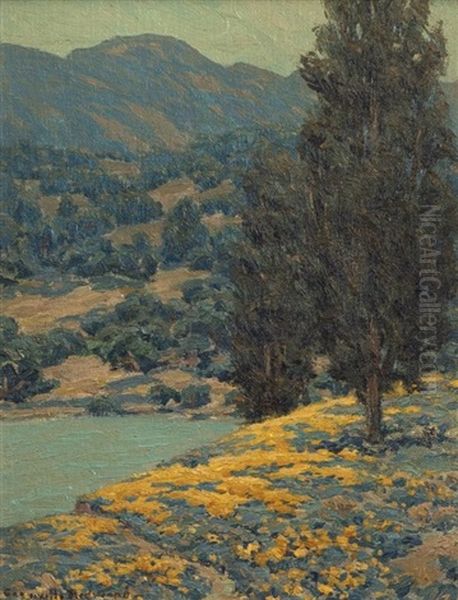
Redmond's work from this period began to show the influence of European styles. While maintaining a degree of academic structure learned under Laurens and Constant, his brushwork loosened, and his palette brightened, reflecting an engagement with Impressionist techniques. He exhibited his painting Matin d'Hiver (Winter Morning) at the prestigious Paris Salon of 1895, a significant honor for a young American artist and an indication of his growing mastery and recognition.
Return to California and Artistic Maturity
In 1898, Granville Redmond returned to California, initially settling in Los Angeles. He brought back with him the sophisticated techniques and broadened artistic vision acquired during his years in Paris. He quickly established himself as a leading figure in the burgeoning Southern California art scene. He married Carrie Ann Jean, who was also deaf and a former student of the Illinois School for the Deaf, in 1899. Together, they had three children.
Over the next few decades, Redmond moved several times, maintaining studios in various parts of California, including Laguna Beach, San Mateo, and Parkfield. However, he spent a significant portion of his career based in Southern California. The diverse landscapes of the state became his enduring subject matter – from the rolling hills covered in vibrant wildflowers to the serene coastal vistas and the majestic oak and eucalyptus trees that dotted the terrain.
His reputation grew steadily. Redmond became known for his ability to capture the distinctive qualities of the California light and atmosphere. He worked prolifically, producing a large body of work that resonated with both critics and the public. His paintings were sought after by collectors and were frequently exhibited in galleries and museums throughout California and beyond.
Artistic Style: Bridging Impressionism and Tonalism
Granville Redmond's artistic style is often characterized as a unique synthesis of California Impressionism and Tonalism. These two movements, while distinct, shared an emphasis on capturing mood and the effects of light, albeit with different approaches to palette and atmosphere. Redmond skillfully navigated between these styles, sometimes leaning more towards one than the other, but often creating works that harmoniously blended elements of both.
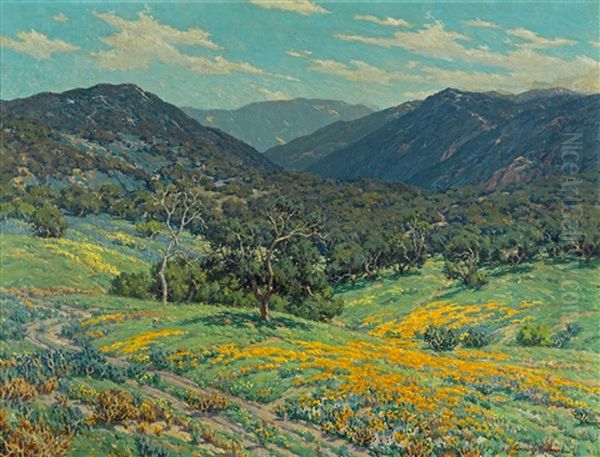
His Impressionist tendencies are evident in his brighter, more vibrant canvases, particularly those depicting fields of California wildflowers – poppies, lupines, and others – under the brilliant sunshine. In these works, he employed broken brushwork, a hallmark of Impressionism, to capture the fleeting effects of light and color. His palette became rich and varied, reflecting the intense hues of the California landscape. These paintings, often characterized by a sense of immediacy and plein air freshness, align him with other California Impressionists like Guy Rose and William Wendt, who also sought to capture the state's unique luminosity.
Simultaneously, Redmond was a master of Tonalism. This style, which had roots in the French Barbizon school and the work of artists like James McNeill Whistler, emphasized mood, atmosphere, and subtle gradations of color within a limited tonal range. Redmond's Tonalist works often depict scenes at twilight, dawn, or under moonlight. These paintings feature soft, diffused light, muted palettes, and a sense of quiet contemplation and poetic melancholy. His nocturnes and paintings featuring fog or haze are prime examples of his Tonalist sensibility, evoking a profound sense of peace and mystery. Artists like Arthur Mathews and Xavier Martinez were also key figures in California Tonalism.
What makes Redmond's work particularly compelling is his ability to move fluidly between these approaches or combine them. Even in his brighter Impressionist scenes, there is often an underlying Tonalist sensitivity to mood and atmosphere. Conversely, his Tonalist works frequently possess a subtle vibrancy of color that hints at his Impressionist training. This duality allowed him to capture the full spectrum of California's natural beauty, from its dazzling sunshine to its ethereal, misty moments.
Key Themes and Subjects: Celebrating California
The California landscape was Granville Redmond's muse. His body of work serves as a visual celebration of the state's natural splendor during a period before widespread urbanization transformed many of the scenes he painted. Certain themes and subjects recur throughout his oeuvre, becoming signature elements of his art.
Perhaps most famously, Redmond is known for his depictions of California wildflowers. He painted countless canvases featuring rolling hills blanketed in vibrant California poppies (the state flower), deep blue lupines, and other native blooms. These works capture the breathtaking spectacle of spring in California, often contrasting the bright oranges, yellows, and blues of the flowers against the green or golden brown of the hills and the clear blue sky. These paintings are often rendered in his more Impressionistic style, emphasizing color and light.
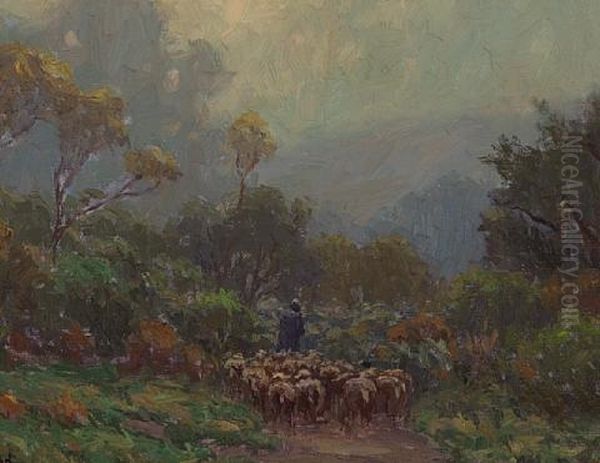
Coastal scenes also feature prominently in his work. He painted the dramatic cliffs, sandy beaches, and shimmering waters of the Pacific Ocean, capturing the interplay of light on water and the atmospheric effects of coastal fog. His seascapes range from bright, sunlit views to more Tonalist interpretations of the coast at dusk or under moonlight.
Trees, particularly California's native oaks and the introduced eucalyptus, were another favorite subject. Redmond depicted them standing majestically in open fields, clustered in groves, or silhouetted against twilight skies. His paintings often convey the distinctive character and form of these trees, using them as strong compositional elements that anchor the landscape and contribute to the overall mood. His painting Eucalyptus Grove is a fine example of this focus.
Furthermore, Redmond excelled at capturing different times of day and varying weather conditions. His Tonalist works often explore the subtle beauty of dawn, dusk, and night. Moonlit landscapes were a recurring theme, allowing him to explore nuances of light and shadow in a muted palette, creating scenes of profound tranquility and poetic beauty. These works showcase his mastery of atmosphere and his ability to evoke deep emotional responses through landscape.
Representative Works
While Redmond produced a vast number of paintings, several works stand out as particularly representative of his style and subject matter:
California Landscape With Flowers: This title represents a common theme and likely refers to numerous works showcasing his signature subject – fields of vibrant wildflowers, often poppies and lupines, under a bright California sky. Such paintings exemplify the Impressionist side of his work, celebrating color and light. A prominent example is held by the Irvine Museum Collection at the University of California, Irvine.
Coastal Wildflowers: Similar to the above, but specifically locating the wildflower fields near the coast, allowing for the inclusion of the ocean or coastal haze in the background. These works combine his love for floral landscapes with his interest in coastal scenery.
Solace: The title suggests a work likely leaning towards his Tonalist sensibility, perhaps a quiet landscape at dusk or dawn, or a scene imbued with a sense of peace and introspection. Tonalist works often carried titles hinting at mood or emotion.

Eucalyptus Grove: As mentioned, Redmond frequently painted eucalyptus trees. A work with this title would focus on a grouping of these distinctive trees, likely exploring the way light filters through their leaves or their silhouettes against the sky, possibly at sunset, as seen in the example sold at Clars Auction Gallery.
Glimpse of Sky: This title implies a focus on atmospheric effects, perhaps clouds, changing light, or the vastness of the sky above the landscape, potentially rendered in either an Impressionist or Tonalist manner depending on the specific light and mood captured.
These examples highlight the recurring motifs and stylistic range in Redmond's art, from the brightly lit, colorful depictions of wildflower fields to the more subdued, atmospheric renderings of coastal scenes and twilight landscapes.
The Hollywood Connection: Friendship with Charlie Chaplin
Beyond the traditional art world, Granville Redmond formed a unique and significant friendship with the legendary silent film star Charlie Chaplin. The two met around 1917 after Redmond had moved his studio to Los Angeles to be closer to the burgeoning film industry, where he hoped to find work as an actor. Chaplin, who had a studio nearby, was immediately struck by Redmond's expressive face and pantomimic abilities, which Redmond had honed partly due to his deafness.
Chaplin became a great admirer and supporter of Redmond's work. He collected Redmond's paintings extensively and provided the artist with studio space on his movie lot. This support was invaluable, offering Redmond financial stability and a dedicated place to paint. Chaplin reportedly found Redmond's Tonalist landscapes particularly calming and displayed them in his home and studio.
Their friendship was mutually beneficial. Redmond taught Chaplin sign language and refined the comedian's pantomime techniques. Chaplin believed that Redmond's natural expressiveness, heightened by his reliance on visual communication, offered insights into conveying emotion and narrative without words – essential skills for silent film. Chaplin famously remarked on Redmond's ability to convey complex emotions through gesture and facial expression.
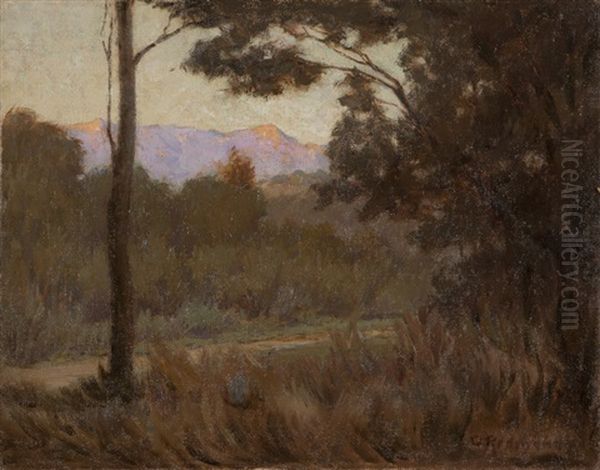
Chaplin also cast Redmond in several of his films, providing him with small acting roles. Redmond appeared as the saloon owner in A Dog's Life (1918), a guest in Sunnyside (1919), a diner patron in A Day's Pleasure (1919), and notably as the sculptor in the poignant opening scene of City Lights (1931). Redmond also pursued acting roles independently, appearing in films for other studios, making him a pioneering figure for deaf actors in Hollywood. His friendship with Chaplin remains one of the most fascinating intersections of fine art and early cinema history.
Contemporaries and the California Art Scene
Granville Redmond worked during a vibrant period for art in California. He was a key member of the group of artists now known as the California Impressionists, who adapted European Impressionist techniques to capture the unique light and landscapes of the American West. He exhibited alongside many prominent figures of this movement.
His contemporaries included artists such as:
Guy Rose: Often considered the leading figure of California Impressionism, known for his Giverny-influenced style.
William Wendt: Called the "Dean of Southern California artists," famous for his powerful, structured landscapes.
Franz Bischoff: Renowned for his vibrant floral paintings, especially roses, and later for his Impressionist landscapes.
Edgar Payne: Celebrated for his dramatic depictions of the Sierra Nevada mountains and coastal scenes.
Jean Mannheim: A German-born painter who became influential in the Pasadena art scene.
Elmer Wachtel: Known for his sensitive renderings of the Southern California landscape, often working alongside his wife.
Marion Kavanagh Wachtel: Elmer's wife, a talented watercolorist in her own right, known for her atmospheric landscapes.
Benjamin Chambers Brown: Another key figure, known for his Impressionist views of Pasadena and the Arroyo Seco.
Beyond the core Impressionist group, Redmond's connections extended to artists with different stylistic leanings. His early teacher, Theophilus d'Estrella, remained a lifelong influence. His Paris acquaintances, Gottardo Piazzoni and Douglas Tilden, pursued their own successful careers, Piazzoni becoming a leading California Tonalist and Tilden a renowned sculptor. Redmond also operated within the broader context shaped by figures like Arthur Mathews and Xavier Martinez, who championed Tonalism and the Arts and Crafts aesthetic in Northern California. His interactions with Norman St. Clair, another landscape painter, are also noted.
While the California art scene was generally collegial, there was undoubtedly an element of professional competition for commissions, exhibition space, and critical acclaim. Redmond successfully navigated this environment, establishing a distinct artistic identity that blended Impressionist vibrancy with Tonalist mood, setting his work apart while remaining firmly rooted in the California Plein Air tradition.
Exhibitions, Recognition, and Collections
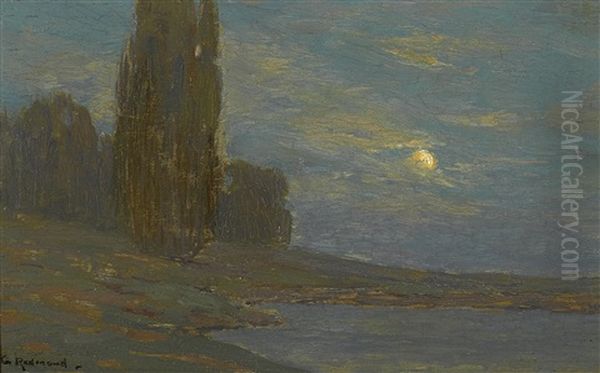
Throughout his career, Granville Redmond received significant recognition for his artistic achievements. His acceptance into the Paris Salon in 1895 was an early indicator of his talent on an international stage. Upon returning to California, he became a regular exhibitor at major venues on the West Coast, including the San Francisco Art Association and various galleries in Los Angeles and San Francisco.
He participated in important expositions, such as the Panama-Pacific International Exposition held in San Francisco in 1915, which was a major showcase for California artists. His work was consistently praised by critics for its beauty, technical skill, and evocative power. The W.E. Brown Medal from the California School of Design remained a notable early honor.
Redmond's paintings were popular with collectors during his lifetime, including prominent figures like Charlie Chaplin. His work entered numerous private collections and, over time, became sought after by public institutions. Today, his paintings are held in the permanent collections of major museums, including:
The Los Angeles County Museum of Art (LACMA)
The Crocker Art Museum, Sacramento
The Oakland Museum of California
The Laguna Art Museum
The Irvine Museum Collection at the University of California, Irvine
The California School for the Deaf, Fremont (holding works by both Redmond and his teacher, d'Estrella)
Retrospective exhibitions have periodically celebrated his work, such as a notable show at the Laguna Art Museum focusing on his landscapes from 1901 to 1931. These exhibitions and the inclusion of his work in museum collections solidify his status as a major figure in American art. His paintings continue to command high prices at auction, reflecting his enduring appeal and historical importance.
Later Life and Enduring Legacy
Granville Redmond continued to paint actively throughout his life, dividing his time between Northern and Southern California. He maintained his friendships, including his close bond with Charlie Chaplin, and remained a respected figure in the art community. His work continued to evolve, though he remained dedicated to capturing the essence of the California landscape he loved so deeply.
He passed away on May 24, 1935, in Los Angeles, at the age of 64. He left behind a rich legacy, both as an artist and as an individual who overcame significant personal challenges to achieve excellence in his chosen field.
Granville Redmond's enduring legacy rests on several pillars. He is recognized as one of the most important and distinctive painters of the California Impressionist movement, celebrated for his unique ability to blend Impressionist color and light with Tonalist mood and atmosphere. His paintings, particularly his iconic depictions of wildflower fields, have become synonymous with the idealized beauty of the California landscape.
Furthermore, Redmond holds a significant place as a pioneering deaf artist. He demonstrated that deafness was no barrier to achieving the highest levels of artistic expression and professional success. His friendship with Charlie Chaplin and his work in silent films also highlight his contribution to the broader cultural landscape of the early 20th century and serve as an inspiration for deaf individuals in the arts.
His work continues to be studied, exhibited, and admired for its technical mastery, its evocative beauty, and its heartfelt connection to the land. Granville Redmond captured a vision of California that is both historically specific and timelessly appealing, securing his place as a master of American landscape painting.
Conclusion: A Singular Vision
Granville Redmond's life story is one of talent, perseverance, and a profound connection to the visual world. Overcoming the challenge of deafness, he developed a heightened sensitivity to light, color, and form, which he translated into breathtaking paintings of the California landscape. As a key figure who masterfully bridged the styles of Impressionism and Tonalism, he created a body of work that is both diverse and cohesive, capturing the vibrant energy and the quiet poetry of his adopted state. His friendship with Charlie Chaplin adds a fascinating dimension to his biography, linking the worlds of fine art and early cinema. Today, Granville Redmond is rightfully celebrated not only as a major California artist but also as an important figure in American art history, whose singular vision continues to inspire awe and appreciation.